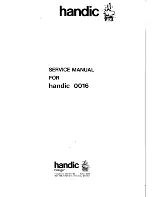
11
Programming the Logic Signalling
From the
Optional Features
screen, use your cursor to select
Logic Signalling
. In order
for the radio to provide proper signaling polarities to the 2012/Merlin and 2016 data
terminal interface on the KCT-19, it is necessary to program the Logic Signalling I/O as
shown in the figure below.
+---------------------------------------- +
¦ Logic Si gnal ¦
¦---------------------------------------- ¦
¦ Squelch Logic Type : [Active Hi ] ¦
¦ Squelch Logic Signal : [TOR] ¦
¦ Access Logic Type : [Active Low] ¦
¦ Access Logic Signal : [Continuous] ¦
¦ Horn Alert Logi c Signal : [Continuous] ¦
+---------------------------------------- +
Programming the Talk Group information for a 2016 Base Modem
The following is an example of how to setup your Kenwood 80 series radio for voice
channel change on base initiated messages.
Group 1
is the
data
channel. This is the
channel that all messages from mobile units will be received on.
Group 2
is the channel
that all of the
voice
traffic will be occurring.
When the 2016 base modem keys up the base radio to send a outbound message, the
radio will be switched to
Group 2
;
after the transmission it will immediately revert back
to
Group 1
to listen for messages from any MDT unit.
Follow the screen shots below to program the Kenwood radio for group change.
Add data group and voice group to list.
+------------------------------------------------------------------------------+
¦ System No. : 1 Trunking Mode ¦
¦------------------------------------------------------------------------------¦
¦ Grp Option ¦
¦ Grp EncID DecID Grp -Name Call Pwr Transpond LOut Signal TA ¦
¦ 1 1 1 Group 1 No Hi No No None No ¦
¦ 2 2 2 Group 2 No Hi No No None No ¦
¦ 3 ¦
¦ 4 ¦
¦ 5 ¦
¦ 6 ¦
¦ 7 ¦
¦ 8 ¦
¦ 9 ¦
¦ 10 ¦
+--------------------------------------------------------------- ---------------+
Add the Data and voice
group to the system.
Set Squelch Logic
Type to Active Hi
Set Squelch Logic
Signal to TOR

































